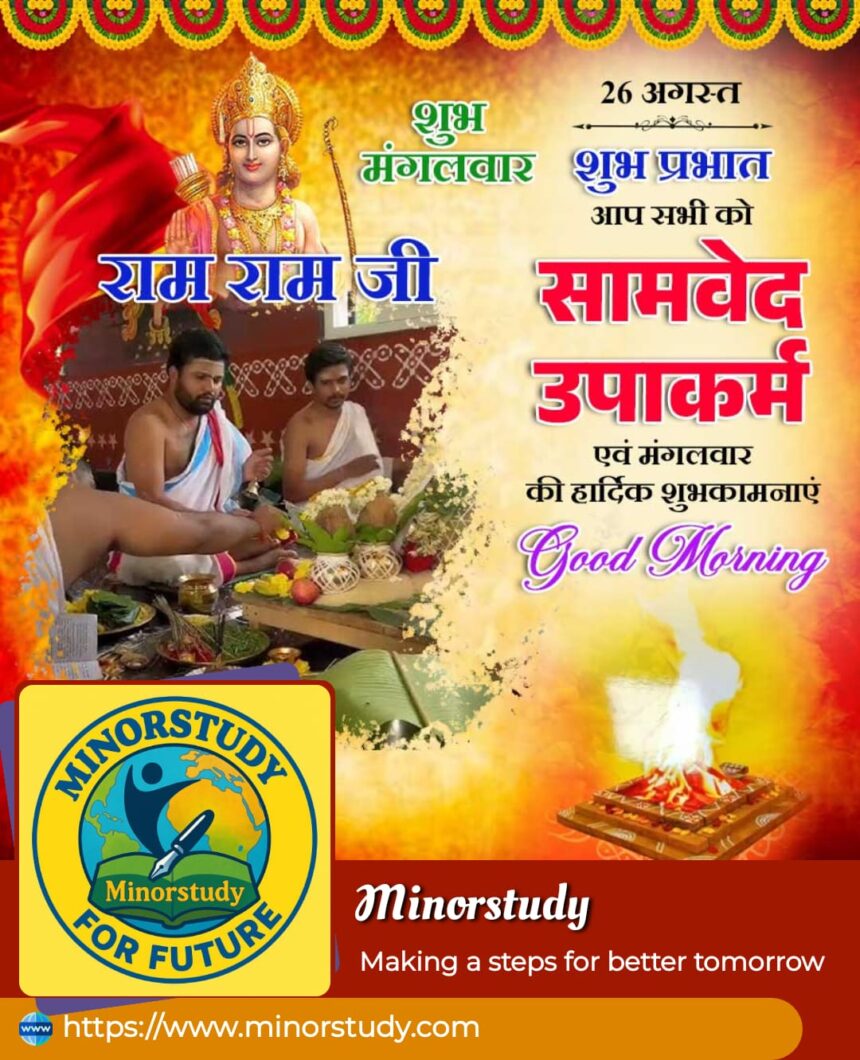🌟 8 Powerful Reasons Why Samaveda Upakarma is a Sacred Festival of Renewal and Knowledge
Introduction
India’s spiritual traditions are deeply rooted in the Vedas, the timeless scriptures that form the foundation of Sanatan Dharma. Among them, the Samaveda is known as the Veda of Melodies (Sama). Its verses are not just recited but sung in melodious tones, making it the basis of Indian classical music and divine rituals.
- Introduction
- 📜 History of Samaveda Upakarma
- 📅 Timeline of Samaveda Upakarma
- 🌟 Important Facts About Samaveda Upakarma
- 🙏 Significance of Samaveda Upakarma
- 🎉 Observance and Rituals of Samaveda Upakarma
- 💐 Wishing on Samaveda Upakarma
- 🌍 Importance in Our Life and Society
- 📌 Important Points About Samaveda Upakarma
- ❓ FAQs about Samaveda Upakarma
- 🌟 Conclusion – Daily Life Impacts of Samaveda Upakarma
One of the most significant observances related to this Veda is Samaveda Upakarma. Celebrated by followers of the Samaveda, this sacred ritual is a festival of learning, renewal, and spiritual purification. On this day, Brahmins perform rituals to seek forgiveness for mistakes in Vedic recitation, renew their sacred thread (yajnopavita), and dedicate themselves to the study of the Vedas with fresh devotion.
Let us explore the history, significance, rituals, timeline, facts, FAQs, and impact of Samaveda Upakarma in detail.
📜 History of Samaveda Upakarma
The Samaveda, one of the four Vedas, is composed mainly of verses from the Rigveda, set to musical notations. It is regarded as the origin of music and chanting traditions in India.
The word Upakarma means beginning or commencement. Samaveda Upakarma marks the ceremonial restart of Vedic studies after a seasonal break.
According to tradition, Rishis introduced this observance to ensure that the recitation of sacred mantras was carried out with purity, devotion, and discipline.
It is also believed that by performing Upakarma, devotees atone for any errors in chanting and seek blessings of the deities for spiritual wisdom.
📅 Timeline of Samaveda Upakarma
Vedic Age (1500 BCE – 500 BCE) – Origin of Upakarma as a ritual for recommencing Vedic studies.
Ancient Period – Practiced widely among Brahmins to preserve oral traditions of Vedas.
Medieval Period – Upakarma became closely linked with social and cultural observances like community prayers and feasts.
Modern Times – Continues to be observed by Samavedi Brahmins, especially in Tamil Nadu, Karnataka, Andhra Pradesh, and other regions of India.
🌟 Important Facts About Samaveda Upakarma
Date of Celebration – Usually observed on Shravana Purnima (Full Moon Day of Shravan month).
Deity Honored – Lord Vishnu, Lord Shiva, and Vedic Rishis are invoked.
Key Ritual – Renewal of the sacred thread (Yajnopavita Dharana).
Sacred Offering – Tarpana (water oblations) to ancestors and sages.
Geographical Practice – Popular in South India and among Samavedi communities.
Spiritual Aim – Atonement for chanting mistakes, renewal of learning.
Connection with Vedic Study – Marks recommencement of chanting and teaching of Vedic hymns.
Cultural Bond – Brings families and communities together through rituals and meals.
🙏 Significance of Samaveda Upakarma
The festival carries deep spiritual, cultural, and educational importance:
Spiritual Renewal – Cleanses mind and soul by seeking forgiveness for past mistakes.
Recommitment to Learning – Symbolizes restarting Vedic studies with new focus.
Preservation of Heritage – Keeps alive the oral tradition of the Samaveda.
Ritual Purity – Renewal of sacred thread signifies spiritual discipline.
Family Unity – Families perform rituals together, reinforcing cultural values.
Connection with Nature – Aligns with Shravan Purnima, a time considered sacred for learning and worship.
🎉 Observance and Rituals of Samaveda Upakarma
The rituals are performed with devotion and precision:
Morning Bath (Snana) – Devotees take a holy dip in rivers or at home before rituals.
Sandhyavandanam – Daily prayers and chanting of mantras.
Tarpana – Offering water to Rishis, deities, and ancestors to express gratitude.
Yajnopavita Dharana – Changing or renewing the sacred thread, a key part of the observance.
Chanting of Mantras – Samaveda mantras are sung in melodious tones.
Homam (Sacred Fire Ritual) – Performed to purify the environment and soul.
Feasting – After rituals, families prepare traditional meals and share them with the community.
💐 Wishing on Samaveda Upakarma
Here are some warm wishes you can share:
🌸 “May the divine blessings of Samaveda Upakarma bring wisdom, peace, and harmony into your life.”
🌸 “On this Samaveda Upakarma, may your spiritual journey be renewed with devotion and knowledge.”
🌸 “Wishing you and your family a blessed Samaveda Upakarma filled with purity and learning.”
🌍 Importance in Our Life and Society
Samaveda Upakarma may seem like a traditional ritual, but its essence is timeless and practical even today:
In Daily Life – Encourages discipline, mindfulness, and self-reflection.
For Students – Acts as a reminder of recommitting to learning with sincerity.
For Families – Strengthens unity through shared rituals and prayers.
For Society – Preserves ancient wisdom and cultural identity.
For Spiritual Seekers – Provides an opportunity to renew one’s devotion and spiritual practice.
For Humanity – Inspires living in harmony with nature and divine order.
📌 Important Points About Samaveda Upakarma
Celebrated on Shravan Purnima.
Associated with the renewal of the sacred thread (yajnopavita).
Involves tarpana, homa, and chanting of Vedic mantras.
Emphasizes purity, knowledge, and devotion.
Still widely observed among Samavedi Brahmins.
❓ FAQs about Samaveda Upakarma
Q1. What is Samaveda Upakarma?
👉 It is a ritual of renewal, forgiveness, and recommencement of Vedic studies associated with the Samaveda.
Q2. When is Samaveda Upakarma observed?
👉 On Shravan Purnima (July–August).
Q3. Who performs Samaveda Upakarma?
👉 Primarily Brahmins associated with the Samaveda tradition.
Q4. Why is the sacred thread changed on this day?
👉 To symbolize purity, spiritual renewal, and recommitment to knowledge.
Q5. How does it connect with daily life?
👉 It teaches discipline, learning, humility, and the importance of self-correction.
🌟 Conclusion – Daily Life Impacts of Samaveda Upakarma
Samaveda Upakarma is not just a ritual; it is a spiritual reset button. It reminds us that no matter how many mistakes we make, there is always an opportunity to renew ourselves with humility and devotion.
In personal life, it inspires discipline, spiritual focus, and learning.
In family life, it reinforces unity and the importance of traditions.
In society, it safeguards ancient wisdom and Vedic heritage.
In spiritual practice, it provides a chance to reconnect with divine energy through prayer and music.
The world today, filled with distractions, needs the message of Samaveda Upakarma—renewal, humility, knowledge, and devotion. By embracing its essence, we enrich not only our personal lives but also contribute to the spiritual progress of society.








